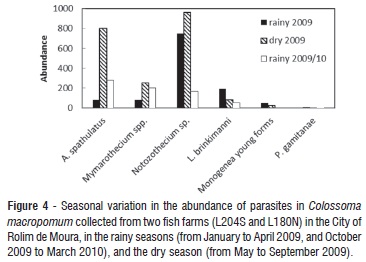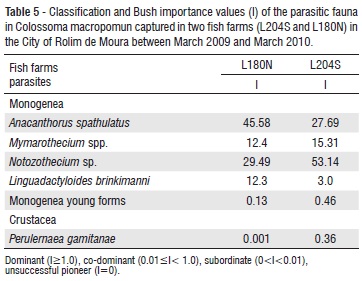Abstracts
In this study we investigated the relationship between tambaqui fish (Colossoma macropomumi Cuvier 1818) and parasites in two fish farms (L204S and L180N) in the state of Rondônia, Brazil, during a 1-year period. The objective of the study was to describe the relationships between parasites, hosts and the environment. From the 80 fish specimens collected, 100% were parasitized by at least one parasite species. Seven ectoparasites species were recorded, six of the class Monogenea: Anacanthorus spathulatusi, Mymarothecium spp. (Mymarothecium sp. 1, Mymarothecium sp. 2 and M. viatorum), Notozothecium sp. and Linguadactyloides brinkimanni, classified as dominants, and the copepod Perulernaea gamitanae, classified as subordinate. Despite their high prevalence, the parasites were not abundant. A. spathulatus presented positive and significant correlations between the abundance of parasitism and the standard length of the hosts in the two fish farms; Mymarothecium spp. showed significant correlations, negative in L180N, and positive in L204S; significant positive correlations were observed for Notozothecium sp. in L204S, and for L.brinkimanni in L180N. Young monogeneans were found; these parasites presented a negative correlation in L180N and a significant negative correlation in L204S. The results of the correlation between the relative condition factor (Kn) and the abundance of parasites were not significant for the recorded parasite species. Regarding the hepatosomatic relation (HSR) of fish and the abundance of parasites, Anacanthorus spathulatusi showed a significant negative correlation with the HSR in L180N, and a positive correlation in L204S. Mymarothecium spp. and Notozothecium sp. presented significant positive correlations in L204S. Considering the correlation of the fish splenosomatic relation (SSR) and the abundance of parasites, L. brinkimanni presented significant correlations, positive in L180N and negative in L204S. Despite 100% prevalence, the high water quality contributes to infracommunities with low parasite abundance and good levels of Kn, HSR and SSR, allowing good tambaqui development.
fish farms; tambaqui; parasites; ecological relationships

 Parasite-host relationship between the tambaqui (Colossoma macropomum Cuvier 1818) and ectoparasites, collected from fish farms in the city of Rolim de Moura, State of Rondônia, Western Amazon, Brazil
Parasite-host relationship between the tambaqui (Colossoma macropomum Cuvier 1818) and ectoparasites, collected from fish farms in the city of Rolim de Moura, State of Rondônia, Western Amazon, Brazil







